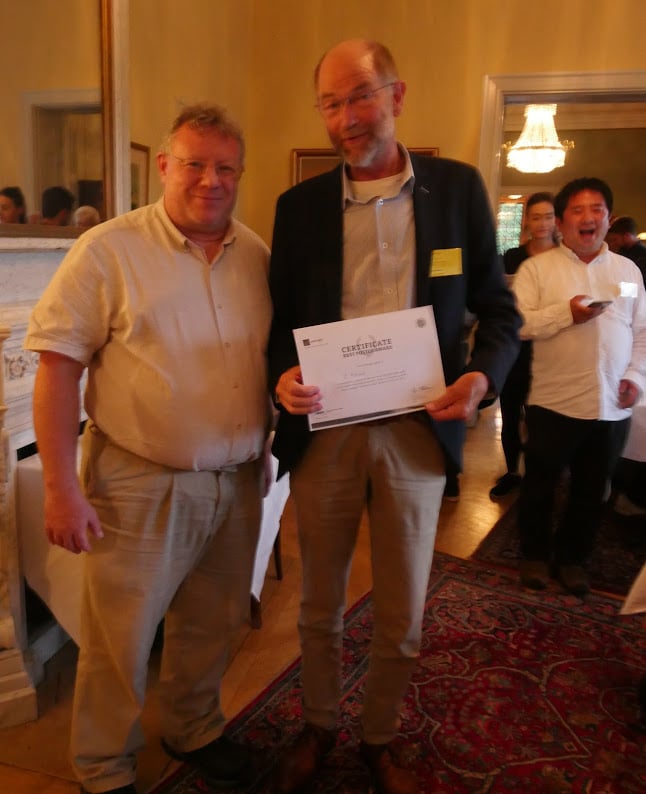26 June 2019
Entropy Best Poster Awards at Quantum Information Revolution: Impact to Foundations (QIRIF)
You are accessing a machine-readable page. In order to be human-readable, please install an RSS reader.
All articles published by MDPI are made immediately available worldwide under an open access license. No special permission is required to reuse all or part of the article published by MDPI, including figures and tables. For articles published under an open access Creative Common CC BY license, any part of the article may be reused without permission provided that the original article is clearly cited. For more information, please refer to https://www.mdpi.com/openaccess.
Feature papers represent the most advanced research with significant potential for high impact in the field. A Feature Paper should be a substantial original Article that involves several techniques or approaches, provides an outlook for future research directions and describes possible research applications.
Feature papers are submitted upon individual invitation or recommendation by the scientific editors and must receive positive feedback from the reviewers.
Editor’s Choice articles are based on recommendations by the scientific editors of MDPI journals from around the world. Editors select a small number of articles recently published in the journal that they believe will be particularly interesting to readers, or important in the respective research area. The aim is to provide a snapshot of some of the most exciting work published in the various research areas of the journal.
Original Submission Date Received: .
We are pleased to announce the winners of the two poster awards that Entropy sponsored at the Quantum Information Revolution: Impact to Foundations (QIRIF) in Växö (Sweden) on 10–13 June, 2019. The Editor-in-Chief of Entropy, Prof. Dr. Kevin H. Knuth (University at Albany, NY, USA), granted the certificate to the winners.
1st prize (350 CHF, certificate)
"Local Observer-Independent Facts is a weaker assumption than Local Causality" by Anibal Utreras-Alarcon
We study the set of correlations that satisfy the assumptions of freedom of choice, locality (defined as parameter independence) and observer-independent facts. The set of these assumptions was previously shown to be in contradiction with the prediction of quantum theory by Caslav Brukner (Brukner, Entropy 20, 350 (2018)). We found that these correlations are not only different from quantum correlations, but also from those that are characterized by a local hidden-variables model. Indeed, the set of local observer-independent facts correlations is a superset of the set of the local hidden-variables model.

2nd prize (150 CHF, certificate)
"Using the Quantum Zeno Effect to Create Phase Contrast in Electron Microscopy" by Pieter Kruit
The concept of interaction-free measurements as proposed by Elitzur and Vaidman [1] for photons, should also work with electrons [2]. When built into a transmission electron microscope [3], this may lead to imaging modes with reduced damage. In our scheme, the electron wave is split by an amplitude splitter in a large component (the reference beam) that passes through a hole in the specimen and a small component (the sample beam) that passes through the sample. After the passage, both beams are cycled back to the amplitude splitter and the process is repeated. If the sample has no effect on the beam, the amplitude in the sample beam slowly builds up until it has the full intensity after m cycles. If the sample does have an influence, either on the amplitude or on the phase, the intensity transfer is disturbed by the quantum Zeno effect, and the intensity stays in the reference beam. Using the model explained in [4], the signals in the reference beam (R) and the sample beam (S) can be calculated as a function of the phase change in the specimen. To get an impression of what kind of images our method would produce, we simulate electron microscopy images of proteins and show “iso-phase lines” or “iso-phase areas” while only causing damage around these lines or in these areas.
[1] Elitzur, A.C.; Vaidman, L. Found. Phys. 1993, 23, 987–997.
[2] Putnam, W.; Yanik, M. Phys. Rev. A 2009, 80, 040902.
[3] Kruit, P.; R.G. Hobbs; C.-S. Kim; Y. Yang; V.R. Manfrinato; J. Hammer; S. Thomas; P. Weber; B. Klopfer; C. Kohstall; T. Juffmann; M.A. Kasevich; P. Hommelhoff; K.K. Berggren. Ultramicroscopy 2016, doi:10.1016/j.ultramic.2016.03.004.
[4] Thomas, S.; Kohstall, C.; Kruit, P.; Hommelhoff, P. Phys. Rev. A 2014, 90, 053840.
[5] The authors acknowledge funding from the Gordon and Betty Moore Foundation and the Netherlands Organization for Scientific Research (NWO).

